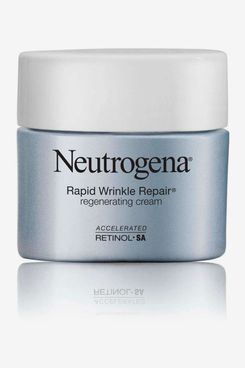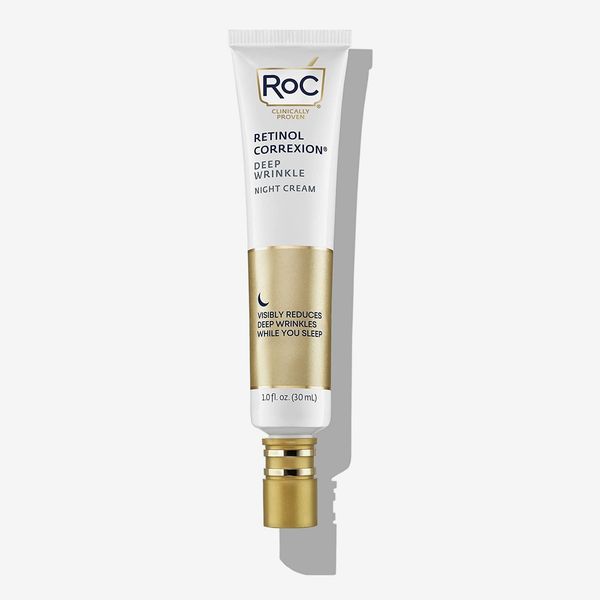
Machiavelli said it was better to be feared than loved, but retinoid wants it both ways. People love it because it’s scientifically proven to be the most useful anti-aging ingredient around, but before you can start to see the benefits, you often have to make it through the fearsome “retinoid uglies.”
A topic discussed with terror all over Reddit’s skin-care boards, the uglies are a transition period in which skin often looks flaky, itchy, red, or dry as it adapts to retinoid. The effects can often make people want to stop using it altogether, but you must persevere to reach the pearly gates of Good Retinoid Skin.
Because the uglies can linger for up to a month, winter (or any time you may otherwise be hibernating) is a good time to try out retinoids. Below, dermatologists give us the breakdown on this essential skin-care ingredient and how to incorporate it into your routine.
What Is a Retinoid, Exactly?
The word “retinoid” is an “umbrella term describing products containing vitamin A, which bind to specific receptors in the skin called retinoid receptors,” says Robyn Gmyrek, M.D., a board-certified dermatologist at UnionDerm in New York and former director of cosmetic dermatology at Columbia University. You might read about retinol or retinoic acid — those are types of retinoids. And they’re all widely used. Shereene Idriss, M.D., board-certified dermatologist, and founder of Idriss Dermatology (and the instant-classic skin-care brand PillowtalkDerm), calls retinoids the “royal family of skin care” (the whole family, before Meghan and Harry seceded) because they’re a staple of 99.99 percent of dermatologist-recommended skin-care routines.
What Are the Benefits of Retinoids?
New skin cells make your skin look bright, shiny, and glowy. Your body exfoliates naturally in a process called “cell turnover” that takes about 28 days. Retinoids help you to get new skin quicker by speeding that process up. Because pimples are caused in part by clogged pores from skin buildup, retinoids are also a helpful anti-acne tool.
In addition, Gmyrek explains that retinoids can “reduce fine lines and wrinkles by increasing the production of collagen.” They also “improve the thickness of the deeper layer of skin, which otherwise thins with age.” When retinoids bind to retinoid receptors, they can alter the expression of specific genes — and make your skin look a lot better.
Can Anyone Use a Retinoid?
Gmyrek says that retinoids “can be used in most anyone, providing that your skin is not currently dry, irritated, red, painful, or skin-barrier-compromised.” That last bit is important unless you want some serious uglies in your future, so even if your face is in a good place, identifying your skin type can help you find a good retinoid — and formula strength — for you.
What’s the Best Percentage of Retinoid to Use?
The first thing you may notice when shopping for retinols is the numbers — and we don’t just mean the price. We asked Nicole Hayre, M.D., board-certified dermatologist at the Cosmetic Dermatology Center in McLean, Virginia, and founder of skin-care brand Cutocin, to give us the lowdown on what skin type works best with a given retinol strength.
“Dry skin will be a little more sensitive when starting a retinoid,” says Hayre, so she recommends looking for a lower percentage of retinoid (such as 0.05–0.1 percent). On the flip side, Hayre says, “Oily skin tends to be more resilient, so most people with oily skin will be able to use a stronger retinol concentration (0.3–0.5 percent) from the start.” Of course, if you find the uglies are too much to bear, you can dial down your frequency of usage or try something gentler.
What Kind of Retinoid Formula Should I Use?
To avoid your going down a retinoid rabbit hole, we asked Marisa Garshick, M.D., board-certified dermatologist at Manhattan Dermatology and Cosmetic Surgery and adviser of the skin-care brand BioRepublic, to clear things up.
“A cream-based retinol or product that contains an encapsulated retinol is best for those with dry skin,” says Garshick, as “[the] gradual delivery can help to minimize irritation of the skin.” She says a retinol gel can be a good option for someone with oily skin since gels tend to have more of a drying effect and can help to address excess oil.
“That said, regardless of skin type,” Garshick advises, “it is always important to incorporate products to help support the skin barrier and nourish and hydrate the skin, to minimize potential retinoid irritation.”
When Should You Not Use Retinoids?
If you’re pregnant, trying to get pregnant, or breastfeeding, retinoid use is generally discouraged. (In the meantime, you can take a look at our favorite pregnancy-safe skin-care products.)
You’ll also want to take care if you have any skin concerns like rosacea, eczema, or severe acne because retinoids can make any — or all of — these woes worse. If you really want to test the waters, make sure to speak with a dermatologist before getting into even drugstore options.
What Can I Expect When Using a Retinoid?
If you’re in the clear to begin using retinoids, prepare for some not-cute things (temporarily). Until your skin gets used to them, it will most likely be red, itchy, flaky, and really dry-looking — the dreaded “retinoid uglies.” It lasts for about a month. “It is difficult to camouflage, and makeup sticks to the dead skin cells, often making it look even worse. So, yes, quarantine is a great time to try a retinoid!” says Gmyrek.
You could also have more breakouts. Because of the skin sloughing, your skin will start “purging,” as they call it on the Reddit message boards. “You might see deeper blackheads come up to the surface, and more breakouts. For acneic skin, it will get worse before it gets better,” says Idriss. If your skin feels painful or you’re seeing pus, stop the retinoid completely and wait. Once you break through the uglies, your skin will adapt and it will have “debulked.” Just be very aware that it won’t be quick. It takes about eight to 12 weeks to see positive results — when your skin will actually start looking brighter and clearer.
How Do You Use Retinoids in a Skin-care Routine?
Short answer: carefully. But you also don’t need to be intimidated. Here are tips from the derms to minimize the uglies.
- P.M. or bust. Retinoids “are not stable in the sunlight,” so only use them at night. Follow up with sunscreen during the day (yes, even in winter).
- Don’t use a retinoid every day. Your skin is not a sourdough starter. “Start by using it for two or three nights every week, then increase the frequency as tolerated based on how your skin responds,” says Garshick.
- Less is truly more. Experts agree that a pea-size amount of product is enough for your entire face.
- “Do not apply to damp or wet skin. After you cleanse the skin, pat dry and then air dry for a few minutes. Applying to damp skin changes the penetration and can lead to irritation,” says Gmyrek.
- Don’t use harsh chemical exfoliants or acids on the same days you use retinoids. Your skin is busy enough.
- Try an open-face retinoid sandwich. “Putting a moisturizer on before you apply retinoid can help dilute it,” says Idriss.
- Preventative measures are important. Garshick says you can apply Vaseline to the corners of your eyes, lips, and nose, prior to applying retinol to minimize retinoid irritation in those sensitive areas.
- And finally, don’t go ham. Hayre says that one retinoid is sufficient to affect positive changes in the skin.
Below, some retinoids for every level, from novice to expert.
The Best Beginner Retinoid
Garshick says this cream is an especially great retinol option in the winter months and for beginners. “Not only does it provide retinol benefits, but it also contains hyaluronic acid to help boost moisture, improving overall tolerability.”
The Best Intermediate Retinoid
Idriss likes this because it’s formulated with a retinoic acid ester, which is almost as strong as prescription-level but supposedly without any of the irritation.
The Best Expert Retinoid
Not so fast — if you want an expert-level retinoid, you’ll need a prescription. These have names like tretinoin or Tazorac. Curology is an online subscription service that creates custom retinoid products, delivered to your door, following consultations with dermatological providers. They often contain blends of tretinoin, niacinamide, and azelaic acid.
The Retinoid for Sensitive Skin
This drugstore favorite is an excellent option for retinol beginners, and one that Garshick really likes. She says, “It works to help reduce the appearance of fine lines and wrinkles and incorporates hyaluronic acid to help with signs of aging. It can be used a few times weekly and gradually increased to nightly use.”
The Retinoid for Acne-Prone Skin
Garshick says this one is especially good for those with acne-prone skin. “This retinoid can help to prevent and treat breakouts while also improving the appearance of blemishes on the skin,” she says. It’s oil-free and fragrance-free, which means it’s a good option for those with constant breakouts or sensitive skin.
The Retinoid Cream
Another one from RoC, which makes sense, since it was one of the first drugstore brands to stabilize retinol, and this has been a longtime drugstore favorite, with 13,000 five-star ratings on Amazon. The brand doesn’t disclose the percentage of retinol used, but thousands of reviewers contest that it’s a milder inclusion, and RoC says it’s gentle enough to be used daily.
The Retinoid Gel
This gel, which uses a synthetic form of retinol, used to be prescription-only but became over-the-counter a few years ago.
The Retinoid Oil
What’s a skin-care roundup without at least one of the Ordinary’s ultrapopular formulas? People love this oil since it offers moderate strength without immoderate pricing. Just make sure to refrigerate it after opening.
The Treat-Yourself Retinol
“This hydrating night cream nourishes the skin while also delivering retinol benefits,” says Garshick, thanks to its inclusion of plant stem cell along time-released retinol. It’s a pricier option, but has a luxe formula that Garshick says should improve the appearance of fine lines and wrinkles, tone, and overall texture. Sign us up.
The Fancy Retinol Alternative
Anecdotal and scientific evidence support that bakuchiol, a “natural” ingredient, is a great dupe for retinol. Even better, it allows you to skip the retinoid-uglies phase, and it’s safe for pregnant and breastfeeding women to use.
The Budget Retinol Alternative
The Inkey is widely seen as a dupe for the Ordinary, with all of its products under $15. Their Bakuchiol and Retinol Serum both have hundreds of Sephora reviews and close to five stars.
Our Experts:
- Marisa Garshick, M.D., board-certified dermatologist at Manhattan Dermatology and Cosmetic Surgery, clinical assistant professor at Cornell, and adviser of BioRepublic
- Robyn Gmyrek, M.D., board-certified dermatologist at UnionDerm in New York City and former director of cosmetic dermatology at Columbia University
- Nicole Hayre, M.D., board-certified dermatologist at the Cosmetic Dermatology Center in McLean, Virginia, and founder of Cutocin
- Shereene Idriss, M.D., board-certified dermatologist at Idriss Dermatology in New York City, and founder of PillowtalkDerm











